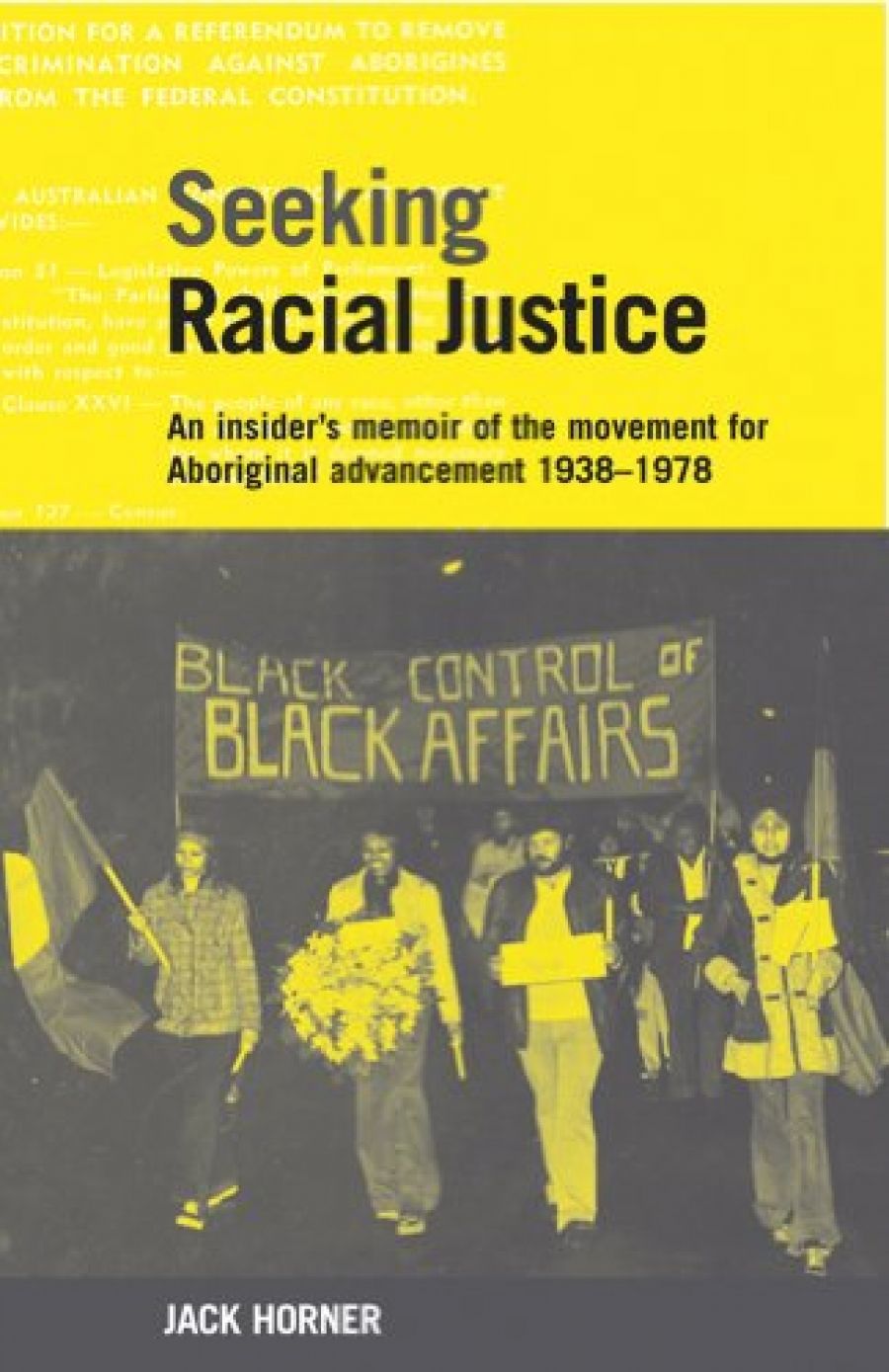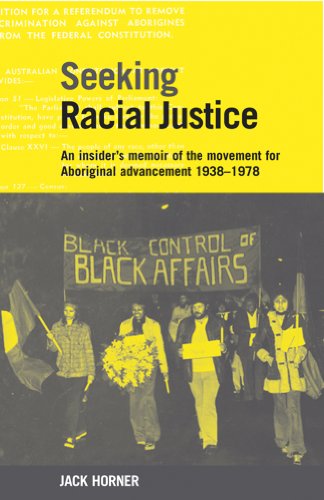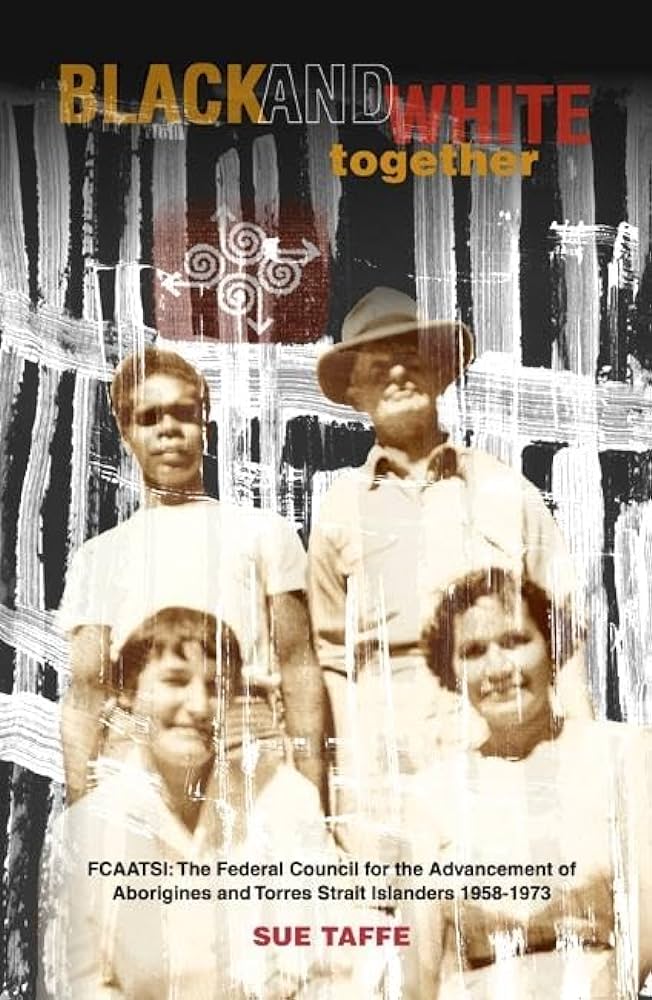
- Free Article: No
- Contents Category: Indigenous Studies
- Review Article: Yes
- Article Title: A shaky foundation
- Online Only: No
- Custom Highlight Text:
The Federal Council for the Advancement of Aboriginal and Torres Strait Islanders (FCAATSI) was a national organisation that existed, in one form or another, from 1958 to 1978. For the main part, it drew its members from a network of both black and white groups, from active citizens and from those who wanted to be counted as such.
Two recent books examine the impact and legacy of this organisation. Black and White Together, by Sue Taffe, provides a detailed overview of the organisation from an historian’s perspective, while Seeking Racial Justice is an ‘insider’s memoir’, written by one of its non-indigenous members, Jack Horner. Both books tell this story in the context of the political shift from segregation to assimilation policies (1938–61), from assimilation to integration (1959–67), and from integration to self-determination (1968–78).
- Book 1 Title: Seeking Racial Justice
- Book 1 Subtitle: An insider’s memoir of the movement for aboriginal advancement, 1938–1978
- Book 1 Biblio: Aboriginal Studies Press, $34.95 pb, 237 pp
- Book 1 Cover Small (400 x 600):

- Book 1 Cover (800 x 1200):

- Book 2 Title: Black and White Together
- Book 2 Subtitle: FCAATSI: The Federal Council for the Advancement of Aborigines and Torres Strait Islanders 1958–1973
- Book 2 Biblio: UQP, $24.95 pb, 408 pp
- Book 2 Cover Small (400 x 600):

- Book 2 Cover (800 x 1200):

Although there is much overlap, which is to be expected, the different perspectives of each author reveal some interesting emphases and variations in the telling of what is essentially the same story. One example is the timing of the policy shift away from assimilation toward that of integration. Taffe states, referencing a report from the 1958 inaugural conference, that the policy of assimilation was ‘vehemently rejected’ by the group, with the word ‘integration’ implying a ‘much truer definition of the Federal Council’s aims’. Horner, on the other hand, claims that it wasn’t until the 1961 conference that the movement ‘began looking at policies of “integration” rather than “assimilation”‘. Moreover, it was not until 1965 that non-indigenous members of the organisation fully grasped the concept of ‘integration’.
The major success of the Federal Council was of course the 1967 referendum, which led to the amendment of the Australian Constitution to remove certain racially discriminating clauses. The major shortcoming of the Federal Council was the failure to make any discernible advancement in land rights, even though this was of most importance to the Aboriginal members. ‘Indecision, hesitancy and the instability of the Land and Reserves Committee seemed to mark the Federal Council’s work on the land issue for much of the 1960s,’ Taffe states. And again: ‘It wasn’t until the 1960s that most white activists came to understand how important land was to Indigenous Australians.’ Indeed, Horner doesn’t really mention the issue until the twelfth annual conference in 1969, which had land rights as its main theme. By then, it was too late for the Federal Council. That the white members did or could not see this earlier is perhaps one of the major factors in the disintegration of the Council in the 1970s.
One reason for this may be that the white perspective was unable to project beyond the framework of both the assimilation and integration models. What is common to both of these policies is that they are concerned primarily with how the indigenous population is to fit in with the broader non-indigenous Australian community. This was the impetus for the 1967 referendum. But this did not address how Aborigines were to maintain their own culture. By not fully grasping that there is an Aboriginal culture, and one intimately connected to the land, white Australians could not appreciate that Aboriginal Australians can only participate effectively within the wider Australian community if they can also draw on their own culture for support.
The Aboriginal members of the Federal Council reacted to this by calling for self-determination. This also precipitated the disintegration of the Council. Since 1960 there had been an all-Aboriginal meeting held prior to the annual conference, and it was thought by the end of the decade, informed by the Black Power ideology of the American civil rights movement, that the organisation itself needed to be an all-Aboriginal affair. As with previous policies, this early form of self-determination carried within it its own self-defeating contradictions. In Australia, this view was best summarised by Kath Walker in 1969, as cited by both Taffe and Horner:
White ‘good-will’ is a shaky foundation on which to build. White Australians, if they choose, can withdraw the ‘good-will’ and black Australians can then be back where they started and have gained nothing for themselves. Black Australians must strengthen themselves into a solid, determined, fighting unit and dictate their own terms for their own advancement. They must define what is best for their own advancement and then they can determine where the white Australians can be of assistance.
It is true that such ‘good-will’ is a tenuous foundation. The problem is that, if this good-will is rejected in advance, there is a risk that later, when one is in a position to ‘determine where the white Australians can be of assistance’, then even this initial good-will may no longer be forthcoming. This is the situation the self-determination movement found itself in during the 1970s. Until then, the Federal Council was an independently funded organisation which, because it did not rely on government funding, and because it had a wide non-indigenous support base, was able to criticise the Australian government and to push for reform from within the community at large. When, in the 1970s, the Aboriginal movement directed itself away from its wide non-indigenous support base, including its sources of funding, and chose to deal directly with government and its newly formed Department of Aboriginal Affairs, it became separated from its real source of strength. In effect, it subordinated itself to the good-will of the government. And in 1978, what had started two decades before as the FCAATSI folded after the government withdrew its funding.
The different perspectives of Taffe and Horner in telling this story reflect the different perspectives that existed within the organisation itself, and the tensions it fostered. In reading these two accounts, it becomes clear that although criticism can be levelled against the various perspectives within the Federal Council, these criticisms only become clear in hindsight and with the whole story before us.
According to Horner, the key to the success of the 1967 referendum was that an appeal had gone out to the Australian people based on their sense of justice, not guilt – and an overwhelming majority of Australians answered in the affirmative. For more than a decade now, black–white relations in Australia have been based on the apportioning of guilt, and on its denial. ‘The challenge to 21st century Australian citizens,’ states Taffe, ‘considering the legacy of FCAATSI, is to forge new collaborations in which black and white Australians can share their insights and ideas in the search for justice.’ These two important books, in considering the legacy of the FCAATSI, mark a good place for us to renew this search


Comments powered by CComment